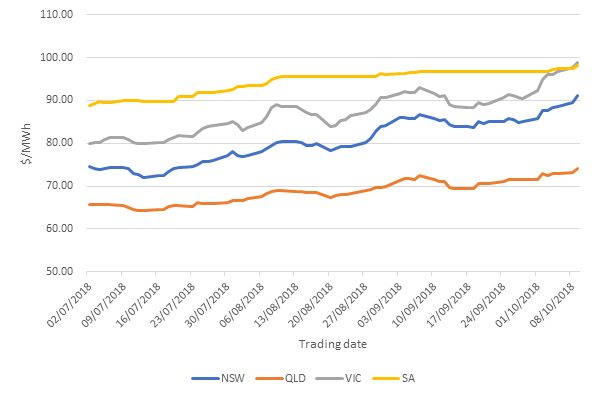The electricity forward price for 2019 continue to increase as fears around system security, adequacy of supply and stressed buyers increase.
Since the start of the financial year, forward prices across all mainland states in the National Electricity Market has been increasing. From 1 July 2018 to close of business 9 October 2018, CAL19 prices have increased by between $8.35/MWh and $18.78/MWh
The largest increase has been in Victoria, closely followed by New South Wales. Victoria has now overtaken South Australia as the most expensive region to purchase 2019 contracts.
Prices have been gradually increasing since the start of the financial year however since Monday 27 August, New South Wales and Victorian prices have increased rapidly.
Over the weekend we experienced lightning strikes on the border between New South Wales and Queensland. One of the main transformers was struct twice at the same time knocking out both the primary and backup line which is attached to the same equipment. The lightning strikes caused the interconnector between the two regions to shut down immediately to prevent further damage to the system. At the time, Queensland was exporting electricity into New South Wales. The sudden loss of electricity from Queensland forced an involuntary load reduction in New South Wales. This also dropped the frequency which may have been a contributing factor in shutting down the interconnector between Victoria and South Australia. AEMO is still investigating the exact cause however this led to involuntary load shedding in both Victoria and Tasmania which is an interconnected region. The majority of the load curtailed was industrial load and all load was restored within an hour.
The prices immediately started increasing when the 2019 market opened Monday morning. Late the next day (after the market had closed) there was another article in the Financial Review questioning the availability of generation due to drought conditions, particularly in New South Wales. The market had been tracking Snowy Hydro water levels, however the article also targeted Bayswater; a large New South Wales coal fired power station. In 2008, Bayswater was forced to curtail generation due to water shortages and could potentially be faced with similar restrictions again.
Though the market was already aware of the current water levels, there was more trading following the load shedding and the drought article. This could be a result of companies being keen to ensure 2019 contracts are in place in the event of further generation curtailments.
The market then seemed to settle again. Forward prices started softening due to lower spot prices in the back half of quarter 3. Late in quarter 3 the price then started to increase again. This was most noticeable in Victoria and New South Wales however it gradually spread to the other NEM regions as well. This is likely due to corporations fixing their 2019 contracts late, and a concern over 2019 spot prices.
Snowy Hydro continues to have little water and it is unclear how much it can generate during 2019. We are seeing generators bid to accommodate more solar PV. Some large generators are reducing their output to keep prices up in the middle of the day. If this continues, we may not see the price drop as some were hoping for.
The last driver is the market having the expectation that some consumers are leaving their contracting until very late. It certainly seems that the buyers are more distressed than sellers, making it difficult to buy cheaper electricity.
If you have any questions regarding electricity forward prices or the electricity market in general, call Edge on 07 3905 9220 or 1800 334 336.
